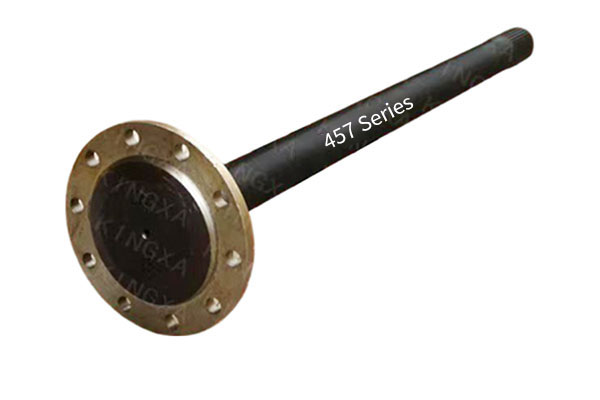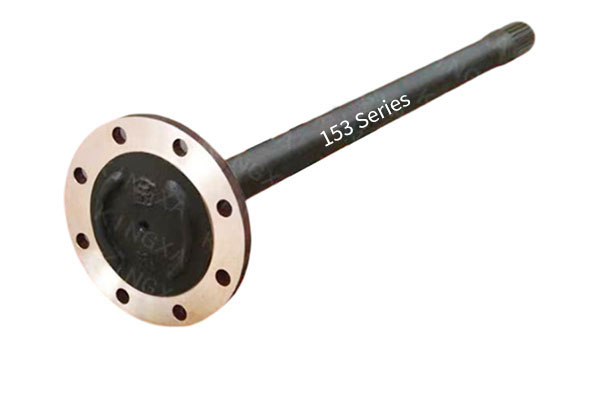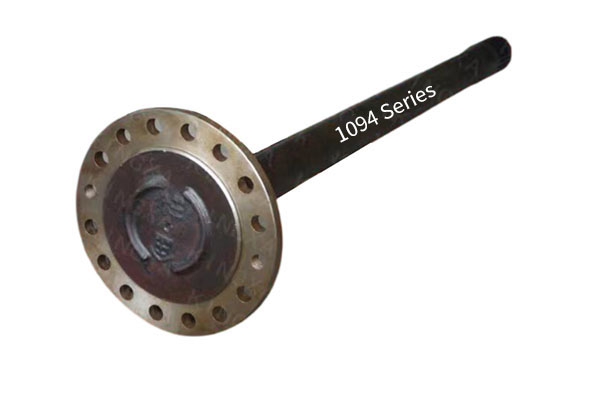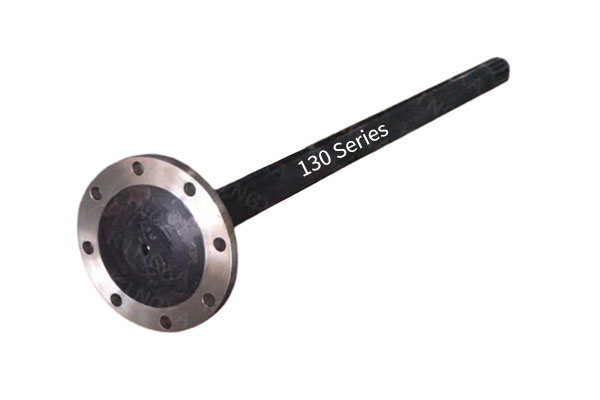How to improve driving safety by choosing the right heavy-duty vehicle rear axle half shaft?
Release Time : 2025-05-12
During the operation of heavy-duty vehicles, the rear axle half shaft is a key component of power transmission, and its performance directly affects the overall safety and reliability of the vehicle. Choosing the right heavy-duty vehicle rear axle half shaft can not only ensure the effective transmission of power, but also significantly improve driving safety and ensure the safety of the driver and cargo. By paying attention to material quality, manufacturing process, design optimization, and intelligent monitoring, the performance of the half shaft can be effectively improved, thereby enhancing the safety of the vehicle.
First of all, the choice of materials is the basis for determining the performance of the half shaft. High-quality alloy steel or high-strength steel is widely used in the manufacture of half shafts for heavy vehicles. These materials have excellent tensile strength and toughness, and can resist fatigue and wear while bearing high loads. Especially in long-distance transportation or heavy-load conditions, strong and durable materials can effectively prevent the half shaft from breaking or deforming, and avoid traffic accidents caused by mechanical failures. In addition, advanced heat treatment technology is also used to improve the microstructure of the material, further enhance its wear resistance and fatigue resistance, and ensure that the half shaft maintains stable and reliable performance in long-term use.
Secondly, precision manufacturing technology is crucial to ensure the quality of half-axles. Modern manufacturing technologies such as CNC machine tool processing and precision forging have greatly improved the production accuracy of half-axles. Accurate dimensional tolerances and surface finish help reduce friction losses and ensure a close fit with the differential and wheel hub. This high-precision assembly not only improves transmission efficiency, but also reduces the risk of accidents caused by looseness or misalignment. At the same time, strict quality control processes run through the entire production process. From raw material inspection to finished product testing, each step is carefully inspected to ensure that every half-axle shipped from the factory can meet the highest standards and provide solid protection for driving safety.
Furthermore, design optimization is also one of the key factors in improving the safety of half-axles. Reasonable geometric design can not only improve the load-bearing capacity of half-axles, but also effectively disperse stress concentration points and reduce the risk of local overload. For example, the use of a gradient diameter design can enable the half-axle to bear corresponding loads at different locations, which not only ensures strength but also reduces weight. In addition, some new designs also introduce internal reinforcement rib structures to enhance the overall rigidity of the half-axle, so that it can still maintain good dynamic balance under complex road conditions. These design improvements not only improve the mechanical performance of the axle, but also indirectly improve the stability of the vehicle during driving, reducing the chance of rollover or other uncontrolled accidents.
It is worth noting that with the advancement of technology, intelligent monitoring systems have also begun to be applied to the status monitoring of axle shafts. By installing sensors to detect the working status of the axle shaft in real time, such as temperature, vibration and other parameters, potential problems can be discovered and warned in time. Once an abnormal situation is detected, the system will immediately notify the driver to check or repair to avoid further deterioration of the fault and cause serious consequences. This proactive preventive measure greatly improves the safety factor of driving, allowing the driver to take countermeasures at the first time to ensure the safety of the journey.
In addition, the maintenance of the axle shaft should not be ignored. Regular professional maintenance can replace worn parts in time, adjust the tightness of the connectors, and ensure that the axle shaft is always in the best working condition. Good maintenance habits can not only extend the service life of the axle shaft, but also reduce traffic safety hazards caused by sudden failures. Therefore, choosing axle shaft products that are easy to maintain and have sufficient supply of accessories is of great significance to improving overall driving safety.
Finally, choosing axle shaft products that meet industry standards and pass strict certification is also an important part of ensuring driving safety. Certification by an authoritative organization indicates that the product has been fully tested and meets specific safety and technical requirements. Purchasing such products not only provides users with quality assurance, but also provides a legal basis and support for possible subsequent problems. By selecting high-quality half shafts, companies have demonstrated their high attention to customer safety and social responsibility and established a responsible brand image.
In summary, heavy-duty vehicle rear axle half shafts can improve driving safety on multiple levels through careful selection of materials, application of advanced manufacturing processes, optimized design, introduction of intelligent monitoring, and attention to daily maintenance. It is not only a core component for power transmission, but also an important line of defense to protect the safety of driver's life and property. In the future development, with the continuous emergence of new materials and new technologies, it is believed that half shafts will play a more important role in improving driving safety and help the automotive industry move towards a safer and more efficient new era.
First of all, the choice of materials is the basis for determining the performance of the half shaft. High-quality alloy steel or high-strength steel is widely used in the manufacture of half shafts for heavy vehicles. These materials have excellent tensile strength and toughness, and can resist fatigue and wear while bearing high loads. Especially in long-distance transportation or heavy-load conditions, strong and durable materials can effectively prevent the half shaft from breaking or deforming, and avoid traffic accidents caused by mechanical failures. In addition, advanced heat treatment technology is also used to improve the microstructure of the material, further enhance its wear resistance and fatigue resistance, and ensure that the half shaft maintains stable and reliable performance in long-term use.
Secondly, precision manufacturing technology is crucial to ensure the quality of half-axles. Modern manufacturing technologies such as CNC machine tool processing and precision forging have greatly improved the production accuracy of half-axles. Accurate dimensional tolerances and surface finish help reduce friction losses and ensure a close fit with the differential and wheel hub. This high-precision assembly not only improves transmission efficiency, but also reduces the risk of accidents caused by looseness or misalignment. At the same time, strict quality control processes run through the entire production process. From raw material inspection to finished product testing, each step is carefully inspected to ensure that every half-axle shipped from the factory can meet the highest standards and provide solid protection for driving safety.
Furthermore, design optimization is also one of the key factors in improving the safety of half-axles. Reasonable geometric design can not only improve the load-bearing capacity of half-axles, but also effectively disperse stress concentration points and reduce the risk of local overload. For example, the use of a gradient diameter design can enable the half-axle to bear corresponding loads at different locations, which not only ensures strength but also reduces weight. In addition, some new designs also introduce internal reinforcement rib structures to enhance the overall rigidity of the half-axle, so that it can still maintain good dynamic balance under complex road conditions. These design improvements not only improve the mechanical performance of the axle, but also indirectly improve the stability of the vehicle during driving, reducing the chance of rollover or other uncontrolled accidents.
It is worth noting that with the advancement of technology, intelligent monitoring systems have also begun to be applied to the status monitoring of axle shafts. By installing sensors to detect the working status of the axle shaft in real time, such as temperature, vibration and other parameters, potential problems can be discovered and warned in time. Once an abnormal situation is detected, the system will immediately notify the driver to check or repair to avoid further deterioration of the fault and cause serious consequences. This proactive preventive measure greatly improves the safety factor of driving, allowing the driver to take countermeasures at the first time to ensure the safety of the journey.
In addition, the maintenance of the axle shaft should not be ignored. Regular professional maintenance can replace worn parts in time, adjust the tightness of the connectors, and ensure that the axle shaft is always in the best working condition. Good maintenance habits can not only extend the service life of the axle shaft, but also reduce traffic safety hazards caused by sudden failures. Therefore, choosing axle shaft products that are easy to maintain and have sufficient supply of accessories is of great significance to improving overall driving safety.
Finally, choosing axle shaft products that meet industry standards and pass strict certification is also an important part of ensuring driving safety. Certification by an authoritative organization indicates that the product has been fully tested and meets specific safety and technical requirements. Purchasing such products not only provides users with quality assurance, but also provides a legal basis and support for possible subsequent problems. By selecting high-quality half shafts, companies have demonstrated their high attention to customer safety and social responsibility and established a responsible brand image.
In summary, heavy-duty vehicle rear axle half shafts can improve driving safety on multiple levels through careful selection of materials, application of advanced manufacturing processes, optimized design, introduction of intelligent monitoring, and attention to daily maintenance. It is not only a core component for power transmission, but also an important line of defense to protect the safety of driver's life and property. In the future development, with the continuous emergence of new materials and new technologies, it is believed that half shafts will play a more important role in improving driving safety and help the automotive industry move towards a safer and more efficient new era.







